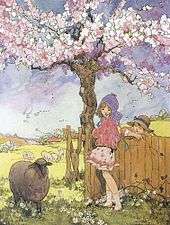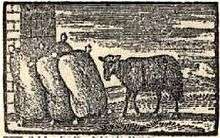Baa, Baa, Black Sheep
| "Baa, Baa, Black Sheep" | |
|---|---|
 Sheet music | |
| Nursery rhyme | |
| Published | c. 1744 |
| Songwriter(s) | Unknown |
"Baa, Baa, Black Sheep" is an English nursery rhyme, the earliest surviving version of which dates from 1731. The words have not changed very much in two and a half centuries. It is sung to a variant of the 1761 French melody Ah! vous dirai-je, maman. Uncorroborated theories have been advanced to explain the meaning of the rhyme. These include that it is a complaint against Medieval English taxes on wool and that it is about the slave trade. In the twentieth century it was a subject of controversies in debates about political correctness. It has been used in literature and popular culture as a metaphor and allusion. The Roud Folk Song Index classifies the lyrics and their variations as number 4439.
Modern version

Recent versions tend to take the following form:
Baa, baa, black sheep,
Have you any wool?
Yes, sir, yes, sir,
Three bags full;
One for the master,
And one for the dame,
And one for the little boy
Who lives down the lane.[1]
The rhyme is a single stanza in trochaic metre, which is common in nursery rhymes and relatively easy for younger children to master.[1] The Roud Folk Song Index, which catalogues folk songs and their variations by number, classifies the song as 4439 and variations have been collected across Great Britain and North America.[2]
Original version

This rhyme was first printed in Tommy Thumb's Pretty Song Book, the oldest surviving collection of English language nursery rhymes, published c. 1744 with the lyrics very similar to those still used today:
Bah, Bah, a black Sheep,
Have you any Wool?
Yes merry I Have,
Three Bags full,
Two for my Master,
One for my Dame,
None for the Little Boy
That cries in the lane.[1]
- ^ Cite error: The named reference
opie1997was invoked but never defined (see the help page).
In the next surviving printing, in Mother Goose's Melody (c. 1765), the rhyme remained the same, except the last lines, which were given as, "But none for the little boy who cries in the lane".[3]
Melody
 |
Baa, Baa, Blacksheep
Tune for Baa, Baa, Blacksheep |
| Problems playing this file? See media help. | |
The rhyme is usually sung to a variant of the 1761 French melody Ah! vous dirai-je, maman, which is also used for "Twinkle Twinkle Little Star" and the "Alphabet song". The words and melody were first published together by A. H. Rosewig in (Illustrated National) Nursery Songs and Games, published in Philadelphia in 1879.[4]
Origins and meaning
As with many nursery rhymes, attempts have been made to find origins and meanings for the rhyme, most which have no corroborating evidence.[3] Katherine Elwes Thomas in The Real Personages of Mother Goose (1930) suggested that the rhyme referred to resentment at the heavy taxation on wool.[5] This has particularly been taken to refer to the medieval English "Great" or "Old Custom" wool tax of 1275, which survived until the fifteenth century.[3] More recently the rhyme has been connected to the slave trade, particularly in the southern United States.[6] This explanation was advanced during debates over political correctness and the use and reform of nursery rhymes in the 1980s, but has no supporting historical evidence.[7] Rather than being negative, the wool of black sheep may have been prized as it could be made into dark cloth without dyeing.[6]
Modern controversies

A controversy emerged over changing the language of "Baa Baa Black Sheep" in Britain from 1986, because, it was alleged in the popular press, it was seen as racially dubious. This was based only on a rewriting of the rhyme in one private nursery as an exercise for the children there and not on any local government policy.[8] A similar controversy emerged in 1999 when reservations about the rhyme were submitted to Birmingham City Council by a working group on racism in children's resources, which were never approved or implemented.[9] Two private nurseries in Oxfordshire in 2006 altered the song to "Baa Baa Rainbow Sheep", with black being replaced with a variety of other adjectives, like "happy, sad, hopping" and "pink".[10] In 2012, a private nursery in Kingston upon Thames replaced "black" with "little" for their Easter show.[11] Commentators have asserted that these controversies have been exaggerated or distorted by some elements of the press as part of a more general campaign against political correctness.[8]
In 2014, there was reportedly a similar controversy in the Australian state of Victoria.[12]
Allusions
The phrase "yes sir, yes sir, three bags full sir" has been used to describe any obsequious or craven subordinate. It is attested from 1910, and originally was common in the British Royal Navy.[13]
The rhyme has often been raised in literature and popular culture. Rudyard Kipling used the rhyme as the title of a semi-autobiographical short story he wrote in 1888.[5] The name Black Sheep Squadron was used for the Marine Attack Squadron 214 of the United States Marine Corps from 1942 and the title Baa Baa Black Sheep was used for a book by its leader Colonel Gregory "Pappy" Boyington and for a TV series (later syndicated as Black Sheep Squadron) that aired on NBC from 1976 until 1978.[14] In 1951, together with "In the Mood", "Baa Baa Black Sheep" was the first song ever to be digitally saved and played on a computer.[15]
Notes
- ↑ Hunt, P. (1997). International Companion Encyclopedia of Children's Literature. Routledge. p. 174. ISBN 0-2031-6812-7.
- ↑ "Searchable database", English Folk Song and Dance Society, retrieved 28 March 2012.
- 1 2 3
- ↑ J. J. Fuld, The Book of World-Famous Music: Classical, Popular, and Folk (Courier Dover Publications, 5th edn., 2000), ISBN 0-486-41475-2, pp. 593-4.
- 1 2 W. S. Baring-Gould and C. Baring Gould, The Annotated Mother Goose (Bramhall House, 1962), ISBN 0-517-02959-6, p. 35.
- 1 2 "Ariadne", New Scientist, 13 March 1986.
- ↑ Lindon, J. (2001). Understanding Children's Play. Cheltenham: Nelson Thornes. p. 8. ISBN 0-7487-3970-X.
- 1 2 Curran, J.; Petley, J.; Gaber, I. (2005). Culture wars: the media and the British left. Edinburgh: Edinburgh University Press. pp. 85–107. ISBN 0-7486-1917-8.
- ↑ Cashmore, E. (2004). Encyclopedia of Race and Ethnic Studies. London: Taylor & Francis. p. 321. ISBN 0-415-28674-3.
- ↑ "Nursery opts for "rainbow sheep"". BBC News Education. 7 March 2006. Retrieved 4 July 2008.
- ↑ "How private school abandoned nursery rhyme's lyrics for Easter show sparking political correctness accusations". Daily Mail. 6 April 2012.
- ↑ "Racial connotations over black sheep prompts changes to Baa Baa Black Sheep at Victorian kindergartens". Herald Sun. 17 October 2014.
- ↑ Partridge, Eric; Beale, Paul (1986). A dictionary of catch phrases: British and American, from the sixteenth century to the present day (2nd revised & abridged ed.). Routledge. p. 547. ISBN 0-415-05916-X.
- ↑ F. E. Walton, Once They Were Eagles: The Men of the Black Sheep Squadron (University Press of Kentucky, 1996), ISBN 0-8131-0875-6, p. 189.
- ↑ J. Fildes, "Oldest computer music unveiled", BBC News, retrieved 15 August 2012.
